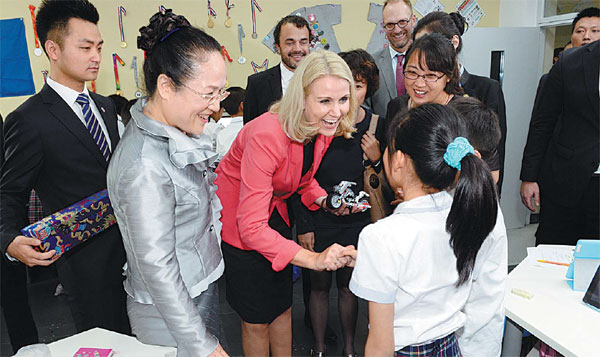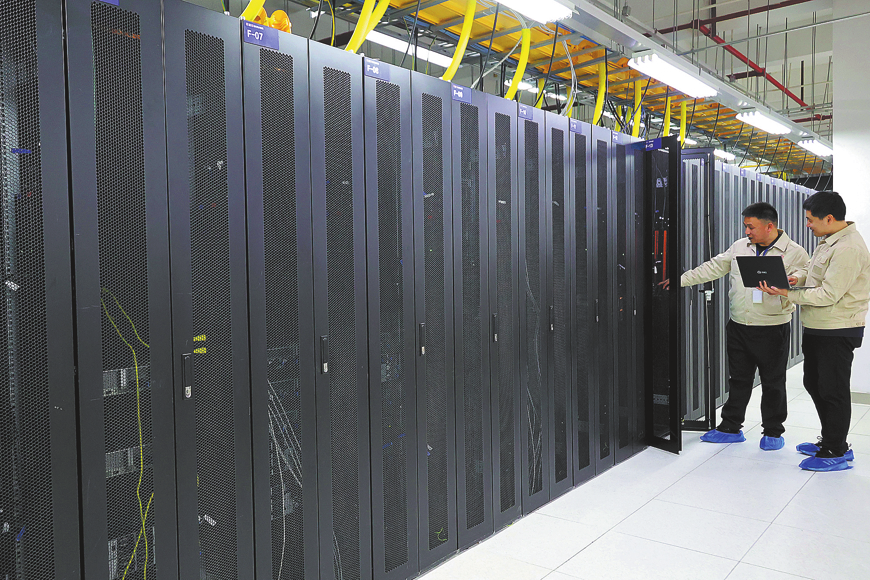Building creative young minds

Danish toy giant-turned-educator hopes its bricks become part of the school curriculum across China
Lego, the Danish construction toy manufacturer, has revealed a Chinese government-backed pilot program that could see its famous colored building bricks become part of the curriculum for thousands of primary and middle pupils across the country.
Jacob Kragh, president of Lego Education, told China Daily the company is set to work with the Ministry of Education on a pilot scheme to be run at 400 schools, which could result in similar pilots being adopted nationwide within the next three years.
| Danish Prime Minister Helle Thorning-Schmidt, with Lego staff, met a Chinese girl when she visited China last month. Provided to China Daily |
Kragh was part of a Danish delegation that visited China last month, accompanying its Prime Minister Helle Thorning-Schmidt.
Speaking at The Primary School Attached to Peking University, the very first of many schools in China already using Lego products as educational aids, Kragh said the Danish firm's education arm has been working closely with education officials since 2010 to develop the latest pilot.
He says children in 10,000 schools across the country already enjoy using Lego as part of their school day.
"The new experiment will allow us to understand the Chinese curriculum better," he says.
"We are working with the ministry and Beijing Normal University to understand Chinese education standards and how teachers work with students to adapt to different situations."
China has a long tradition rote learning in its schools - memorization based on repetition, geared toward getting high scores in exams. But many educators now acknowledge that the method is outdated, and no longer suits the next stages of China's economic growth.
Within that system, its science curriculum, particularly, needs to be rebuilt to nurture more creative, collaborative learning.
The use of Lego bricks in education is widespread across the world, and often involves students working in groups to discuss, collaborate and plan things for themselves.
But teachers, too, have to learn how best to integrate their use into their classes.
"In fact, the teachers are often the biggest challenge," says Lene Friis, director of Lego Education Asia Pacific and Emerging Markets.
Lego is already officially in the primary and secondary school curriculums in Japan and South Korea, for subjects such as science and physics, she says.
Various Lego Education products have been developed for use in schools, in sets that typically contain a large number of pieces.
The products have been used across China since around 2005, with 20,000 teachers in around half as many primary and secondary schools now trained in their use, Friis says.
"We show them how they can improve the innovative skills of the students.
"But those who are using them still represent a small percentage compared to the huge numbers of schools in total in China", she says, adding that many of those she has worked with in the country are very progressive in their thinking.
Most of the 10,000 Chinese schools using Lego education products as aids are in first-tier cities, such as Beijing, Guangzhou, Shenzhen and Shanghai, meaning there is enormous scope to expand nationally.
In North America, a quarter of middle schools and a half of elementary schools are now believed to use Lego education products in class.
"We have seen a huge appetite in China for making and trying out new things, testing and finding out whether things work, and these schools have been using Lego to do that - if it doesn't work for them yet, we will improve on it," Kragh says.
Lego Education began 30 years ago after an increase in requests from teachers who were beginning to use the plastic bricks in their classrooms.
The company says their use promotes the teaching of core curriculum more effectively, and today it sells classroom resources and training packages to teachers in 60 countries.
As its model already proves in Japan and South Korea, governments are now on board with what the company says is a playful approach to learning that allows children to have fun at the same time.
"Lots of parents want to give their children more creativity innovation," Friis says.
Lego provides after-school programs, too, to encourage children to come with their parents and see first-hand how they can work using Lego.
But its use does not go down well with all parents.
Lin Zhiying, for instance, who took his son, 3, to attend classes at a Lego center in the southern city of Shenzhen, says some of the trainers were not skilled enough to motivate children "to think and work freely for themselves".
Like many young Chinese parents, Lin, who was born after 1980, has never played with Lego and added that he learned about science from various sources outside school, including the hit TV series The Big Bang Theory.
However, compared with his parent's generation, he is keen for his son to adopt more innovative learning.
Ren Hui, a science teacher at Peking University's primary school, says she had no idea that Lego's education systems were so hands-on when her school became the first to use them in 2000.
"It was a brand new teaching resource. I had to play and learn it myself from scratch. But the more difficult part was to adopt a teaching approach."
Today the school runs regular science classes using Lego bricks and other programming tools from the company for its grade three, four and five students.
lijing2009@chinadaily.com.cn
(China Daily European Weekly 10/03/2014 page21)
Today's Top News
- Stable trade ties benefit China, US
- New engine powers cargo drone expansion
- China to boost intl cooperation on green tech
- Factory activity sees marginal improvement in November
- Venezuela slams US' 'colonial threat' on its airspace
- Xi: Strengthen cyberspace governance framework































